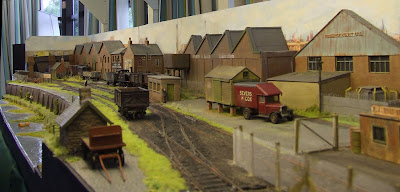My method is nothing ground breaking, all ideas have been borrowed from other modellers. I decided at an early stage to adopt Tortoise point motors and install all motors under the baseboard using Exactoscale's Tortoise Mounting Plates which gave me the horizontal motion. I just needed to decide on how to transfer this horizontal motion vertically through the baseboard to the switch blades.
Also a couple of guys stated that on their P4 layout they used 16.5mm as the distance between switch blades. This sounded too narrow to me but in checking dimensions it seemed OK for the centre to centre measurement between blades. My rough calculations are - P4 standards state a distance of 17.47mm between outer faces of the check rails - in reality on my points this has become 17.38mm - minus 0.9mm for width of rail gives a nominal 16.5mm. No doubt purists will put me right but at the moment it seems to work for me.
Hopefully the diagram below will help to explain the following verbal description.
 I've used 0.5mm brass wire for the wire droppers soldered to the blades. Both wire droppers are bent slightly so that they are vertical to the centre of the blade when they pass though the baseboard. I then drilled the motion arm from the Tortoise mounting plate with two 1.5mm holes at 16.5mm centres. The hole was drilled to pass though the arm. Into each hole I then glued a 13mm length of 1.5mm brass tube. An 18mm length of 1.0mm brass tube, with an internal dimension of 0.5mm, was then soldered into the 1.5mm tube (18mm being the distance from the base of the motion arm to the top of the balsa wood track base). When installed, this will leave just the 0.5mm brass wire passing though the ballast layer. To help with installation when threading the motion arm onto the wire droppers under the baseboard, I cut the wire droppers to different lengths, 24mm and 22mm. When fitted, the wire droppers will protrude through the motion arm which means that the motor cannot be directly under the point but will be offset to one side of the point under the baseboard.
I've used 0.5mm brass wire for the wire droppers soldered to the blades. Both wire droppers are bent slightly so that they are vertical to the centre of the blade when they pass though the baseboard. I then drilled the motion arm from the Tortoise mounting plate with two 1.5mm holes at 16.5mm centres. The hole was drilled to pass though the arm. Into each hole I then glued a 13mm length of 1.5mm brass tube. An 18mm length of 1.0mm brass tube, with an internal dimension of 0.5mm, was then soldered into the 1.5mm tube (18mm being the distance from the base of the motion arm to the top of the balsa wood track base). When installed, this will leave just the 0.5mm brass wire passing though the ballast layer. To help with installation when threading the motion arm onto the wire droppers under the baseboard, I cut the wire droppers to different lengths, 24mm and 22mm. When fitted, the wire droppers will protrude through the motion arm which means that the motor cannot be directly under the point but will be offset to one side of the point under the baseboard.It is all very simple really..........that is, once you know what to do, what to use and how to use it.















































